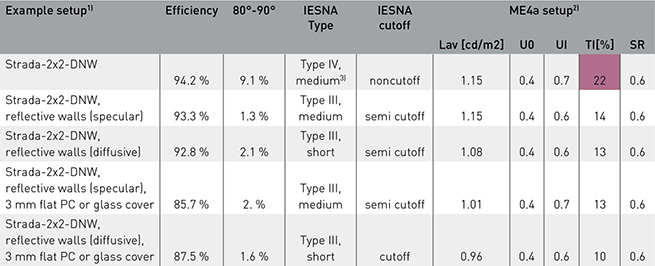GLARE SHIELDING
Fixtures that produce very wide beam angles – which are common in many roadway lighting applications – tend to emit light above 75° angle. This causes glare, which is visually distracting and can lead to unsafe conditions for motor vehicle operators, so it is best that the fixture design limits or eliminates the amount of light above 75° angle.The easiest way to manage glare is to add a casing around the lenses. When the casing walls are higher than the secondary lenses, there will be no light above 90° angle and the amount of light at 75°-90° angles is greatly decreased. Casing with low reflectivity will have an impact on the efficiency of the luminaire so it is always best to use materials with high reflectivity within the luminaire casing.
Flat, transparent covers are often used to protect the luminaire against environmental elements and also to reduce glare. Since a higher percentage of light is reflected back into the luminaire at wider emitting angles, the amount of light that leaves the fixture over 75° angle is reduced and so is glare from the luminaire. Flat covers are also the easiest method to eliminate up-light, in order to meet International Dark-Sky1 and other standards in many countries and local municipalities.
 All glare shields and protective covers have some effect on light distribution, so there is some difference
in the performance of secondary lenses. In most cases, the changes in light distribution do not make a noticeable difference on overall fixture performance. European ME requirements for street lighting, though, sometimes have more issues because the longitudinal uniformity of luminance needs carefully balanced light distribution.
All glare shields and protective covers have some effect on light distribution, so there is some difference
in the performance of secondary lenses. In most cases, the changes in light distribution do not make a noticeable difference on overall fixture performance. European ME requirements for street lighting, though, sometimes have more issues because the longitudinal uniformity of luminance needs carefully balanced light distribution.
1) Wall height 20 mm, Wall distance from lenses 35 mm, Wall inclination 5 deg. – Simulations does not take material absorption values on walls and cover into account. 2) Street width 8 m, Pole height 8 m, Pole distance 32 m, Overhang -0.5 m, no tilt, 10000 lumen per luminaire 3) Close to Type III, medium light distribution
1)http://www.darksky.org/PROTECTIVE COVERS
Flat covers, typically made of glass, are the easiest way to protect a luminaire against environmental elements. A flat shape, unfortunately, has some downside as it decreases the efficiency of the luminaire and slightly changes the light distribution. The transmission percentage of light perpendicular to the cover is close to 100% but decreases when the angle gets wider. On 70° angle the light transmission can drop to 60% or even lower. It is possible to increase the light transmission by adding anti-reflective coating on the flat cover, but this can be an expensive and time-consuming secondary process.Spherical covers have better efficiency than flat covers. The curved shape helps to increase light transmission percentage as the contact angle between the spherical cover and the rays of light at wider angles is less than with a flat cover. This means it is easier to create luminaires with really wide light distribution when using spherical covers. Spherical covers with constant thickness have only a slight effect on the light distribution of the luminaire. Uneven thickness, however, can have a major effect on the light distribution and performance of the luminaire.


1) In each simulated setup the casing is with 100% light absorption. – Wall height 15 mm, Wall distance 175 mm 2) Street width 8 m, Pole height 8 m, Pole distance 32 m, Overhang -0.5 m, no tilt, 10000 lumen per luminaire 3) Close to Type III, medium light distribution
The information contained herein is the property of LEDiL Oy, Joensuunkatu 13, FI-24100 SALO, Finland and is subject to change without notice. Please visit lediloptics.cn for additional information, such as the latest photometric files, 3D mechanical models, and application notes relating to handling, gluing and taping.

